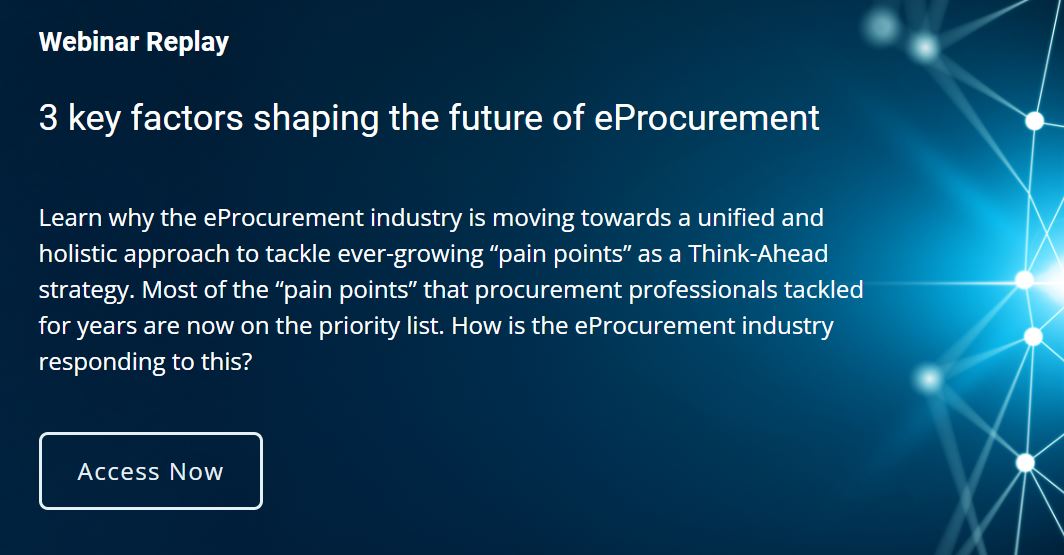The global COVID-19 pandemic caused considerable disruption across the supply chain and procurement industries. As a result, organisations are now starting to assess how they execute their operational tasks, looking for new ways to amplify their savings, stay connected with remote teams, manage their overall cash flows, and ensure complete enterprise-level visibility.
With big changes on the horizon, the next few years will be interesting as we wait to see what eProcurement systems will look like. ELCOM recently delivered a webinar – ‘3 key factors shaping the future of eProcurement’ [REPLAY HERE] that focussed on the importance of digital transformation in procurement. We’ve summarised what was discussed below.
Market context
Pre-pandemic, there was an archaic penchant toward paper-based and manual processes. Almost 10-20% of organisations globally did not have a P2P system in place. Other organisations had multiple processes and tools resulting in poor spend analytics and visibility, duplication and redundancy, as well as rigid governance and compliance.
Post-pandemic, there is an urgency to solve the above pain points. Spend analytics is cited as the digital solution with the greatest potential impact on procurement functions by 50% of respondents in a survey conducted by McKinsey. 69% of these survey respondents considered digital and analytical solutions to be more valuable post-pandemic.
We launched a short poll to understand the pain points of our attendees. 43% of the respondents agreed that paper-based and manual processes were their key pain points followed by spend analytics and visibility. Almost 80% of our respondents also agreed to the fact that successful implementation of a P2P solution is “very important” to them.
With this in mind, the 3 key factors shaping the future of eProcurement are:
Factor 1: P2P Market Direction
The current P2P market centers on cloud-based deployment, but this is expected to change thanks to widespread digital transformation. This shift involves automating E2E procurement processes, moving away from paper-based resources, and turning towards AI-powered guided procurement.
As we move towards the future outcome of the data-driven P2P business model, you can also expect to see growth in the mobile-native approach for faster AP approval, ordering, and KPI visibility. This will provide a more holistic view of the P2P process, helping to build more robust security infrastructures and leading to the implementation of best practices.
Factor 2: P2P: Unified & Holistic Platform
The P2P market is moving from a standalone application to a single holistic procurement platform. Driven by growing market opportunity, procure-to-pay vendors are looking at offering integrated procurement solutions by enhancing the data interoperability & management, intelligence (including advanced analytics, machine learning, and artificial intelligence), and enterprise (from PLM to ERP, CRM to SCM, and finally finance).
The P2P holistic platform helps to boost visibility and optimisation, improve operational efficiency, and improve risk and compliance.
Factor 3: Analytics, AI, and ML
Advanced Analytics, Artificial Intelligence (AI), and Machine Learning (ML) are driving end-to-end performance improvements across P2P stages. Already, they’re being used to automate and optimise end-to-end processes in ePurchasing, eInvoicing, eCatalogue, and supplier analysis to improve quality, service, and performance.
In regards to ePurchasing, AI and ML are being used to provide buying assistance, guiding the user towards the right product by taking into account factors like quality, suppliers, and payment history.
In eInvoicing, AI-based OCRs are helping to increase operational efficiency by automating entire processes. Optical character recognition can dissect information from both physical paper and digital paper, saving comparable time and allowing employees to move on to other tasks, cutting down on operational costs.
In eCatalogue, machine learning is helping to automate product mapping, allowing vendors to automatically categorise their products according to buyer preference.
And finally, in regards to supplier analysis, these tools are providing comprehensive insight into supplier preferences, allowing vendors to access advanced data visualisation opportunities to uncover cost savings.
PECOS and the Scottish Government
As P2P success example, we discussed the case of the Scottish Government and PECOS [LEARN MORE]. Over the last 20 years, the Scottish Government’s eCommerce shared service has grown to be internationally acclaimed as the world’s most successful eProcurement service, with our PECOS P2P being a core component of that service. The last two decades have been a huge success, but that doesn’t mean there haven’t been challenges along the way, especially when rolling PECOS out into the public sector, including schools, universities, and the NHS. The journey has been a real evolution, leading to the formation of an eProcurement Scotland Community. This has stood Scotland in remarkably good stead as they are now at the forefront of procurement trends.
P2P and Beyond
A P2P solution should be a flexible, out-of-the-box solution. P2P implementation has numerous benefits that outweigh the implementation effort. The success of a P2P solution is measured via governance and compliance, its ability to reduce maverick spends, and setting tangible benchmarks that can outline the benefits as well as the potential versus actual savings, and draw up integrated solutions regarding what will work best with P2P.
About ELCOM
ELCOM is a leading supply chain technology provider, with solutions that automate and streamline financial processes to help government agencies, educational institutions, and commercial enterprises to deliver better services and business performance.
It’s been almost 30 years since our journey began when we partnered with MIT to create our world-class PECOS technology. Since then, we have worked hard to grow our offering, coming up with new innovations to meet our clients’ challenges. We continue to enjoy sharing our personal experiences with you.



